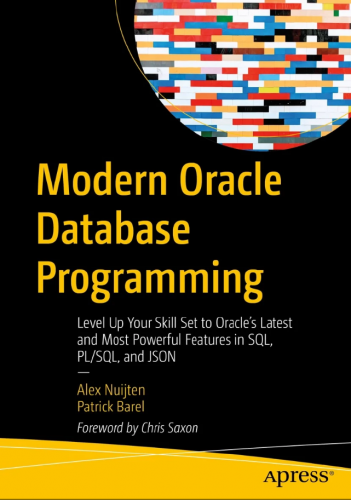LeakGod
Golden Member

- Joined
- May 24, 2024
- Messages
- 264
- Reaction score
- 1,093
- Points
- 43
- Thread Author
- #1
Modern Oracle Database Programming

Level up your skill set to the latest that Oracle Database can offer. This book introduces features that are not well known that can transform your development efforts. You’ll discover built-in functionality that can save you massive amounts of time that otherwise would be spent reinventing the wheel. You’ll find that what used to take a lot of programming some years ago can be done with less code in a more reliable way today. Anyone using Oracle Database without the knowledge in this book is leaving valuable functionality–that their company has paid for–on the table, and this book opens the door to that functionality so that you can deliver reliable and performant solutions faster and more easily than ever.
Part I looks at features in SQL and PL/SQL that are underused and not well known. You’ll learn about new join types, pattern matching across rows, Top N pagination (useful in reporting!), qualified expressions, and enhancements to iterators that reduce code complexity and make your logic easier to understand.
Part II covers how and when to invoke PL/SQL from SQL while maintaining performance. You'll learn about SQL macro functions for creating reusable SQL fragments, polymorphic table functions with return types determined by incoming argument types, and constructing and parsing JSON documents for data interchange with other systems.
Part III introduces a vast array of built-in functionality that Oracle provides that is just waiting to be used. Edition-based redefinition enables zero-downtime application and schema upgrades. Data redaction enables easier compliance with privacy laws and similar regulations by protecting sensitive data from those who have no need to see it. Virtual private databases provide the appearance of giving each user their own database, again helping to secure sensitive data. These features are just a taste of what the book provides. Soon you’ll be improving your skills and wondering why you ever worked so hard to solve problems that Oracle Database already solves for you.
What You Will Learn
- Write more powerful code by incorporating underused features in SQL and PL/SQL
- Optimize your integration between SQL and PL/SQL for best performance
- Take advantage of enhanced set operators, lateral joins, row-based pattern matching, and other advanced features in SQL
- Make your code easier to understand through your use of newer PL/SQL features, such as qualified expressions and iterator enhancements
- Integrate with web services and external data sources directly from the database
- Create and parse JSON documents for easy data exchange and flexible schema design

Level up your skill set to the latest that Oracle Database can offer. This book introduces features that are not well known that can transform your development efforts. You’ll discover built-in functionality that can save you massive amounts of time that otherwise would be spent reinventing the wheel. You’ll find that what used to take a lot of programming some years ago can be done with less code in a more reliable way today. Anyone using Oracle Database without the knowledge in this book is leaving valuable functionality–that their company has paid for–on the table, and this book opens the door to that functionality so that you can deliver reliable and performant solutions faster and more easily than ever.
Part I looks at features in SQL and PL/SQL that are underused and not well known. You’ll learn about new join types, pattern matching across rows, Top N pagination (useful in reporting!), qualified expressions, and enhancements to iterators that reduce code complexity and make your logic easier to understand.
Part II covers how and when to invoke PL/SQL from SQL while maintaining performance. You'll learn about SQL macro functions for creating reusable SQL fragments, polymorphic table functions with return types determined by incoming argument types, and constructing and parsing JSON documents for data interchange with other systems.
Part III introduces a vast array of built-in functionality that Oracle provides that is just waiting to be used. Edition-based redefinition enables zero-downtime application and schema upgrades. Data redaction enables easier compliance with privacy laws and similar regulations by protecting sensitive data from those who have no need to see it. Virtual private databases provide the appearance of giving each user their own database, again helping to secure sensitive data. These features are just a taste of what the book provides. Soon you’ll be improving your skills and wondering why you ever worked so hard to solve problems that Oracle Database already solves for you.
What You Will Learn
- Write more powerful code by incorporating underused features in SQL and PL/SQL
- Optimize your integration between SQL and PL/SQL for best performance
- Take advantage of enhanced set operators, lateral joins, row-based pattern matching, and other advanced features in SQL
- Make your code easier to understand through your use of newer PL/SQL features, such as qualified expressions and iterator enhancements
- Integrate with web services and external data sources directly from the database
- Create and parse JSON documents for easy data exchange and flexible schema design
To see this hidden content, you must reply and react with one of the following reactions :  Like,
Like,  Love,
Love,  Haha,
Haha,  Wow
Wow

